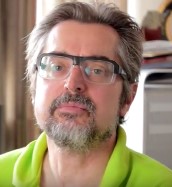
OHTN Applied Research Chair
Mario Ostrowski’s research confronts the basic science of HIV with the aim of making new vaccines and curing HIV infection. His work looks at the machinations of the immune system to see where HIV disarms it. By understanding how HIV blocks the immune system, one can find the Achilles heel of the virus. The research will exploit these findings to develop therapies that can allow the immune system to then clear the virus from the body or prevent infection . iImmune cells that his team that have been shown to attack HIV include, B cells (which make antibodies), cytotoxic CD8 killer T cells (which destroy HIV infected cells), the CD4 helper cells (cells that help and feed the immune system but which HIV attacks) and plasmacytoid dendritic cells (or pDC for short) which produce lots of interferons that stop HIV from growing. His team is also working on Cure research by studying the HIV reservoirs (where HIV hides in the body) and how to eradicate them.
Research Findings
- Mario Ostrowski’s team demonstrated the cytotoxic CD8 killer T cells in HIV infection become exhausted, losing their ability to clear virus from the body. This is in part due to activation of a ‘checkpoint’ immune pathway that involves the molecule called Tim-3. His lab is developing treatment strategies that could be used to block this Tim-3 pathway that would make the killers cells start working again.
- The lab has shown that B cells are also disabled by the virus, due to the presence of something called B10 cells, which produce immunosuppressive molecules in the body.
- The lab has shown that HIV disables the pDCs from making interferons which could stop HIV growth.
- The team has worked on a number of immune stimulating molecules (or adjuvants) that could be used in a vaccine. These are immune molecules naturally produced by the immune system to regulate various immune responses. The lab is investigating the role of CD40L and 41-BBL in enhancing the effects of vaccines to make more killer cells against HIV, and the lab is investigating a molecule called BAFF which can activate the B cell responses to the virus.
- The lab also works on the important problem of co-infections and co-morbidity, such as HCV co-infection. The lab has shown that the immune responses to HIV, actually can target the liver and cause damage, when HCV is also present. The lab also has investigated how HIV can interfere with the immune system response to HCV virus.
- The team has recently completed a study, determining what is the best anti-viral treatment that should be used in early HIV infection (if exposed to the virus within 6 months). They found that a very intensive anti-viral treatment regimen (at least 5 drugs) was no better than the usual standard treatment regimen (3 drugs) in decreasing the HIV reservoirs. The team found that early treatment reduced the HIV reservoirs in the body more than if somebody delayed treatment.
Current Projects
- The team will begin testing new immune based treatments that can be used to target the HIV reservoir in infected people, as a first step to cure HIV Infection. In collaboration with Maple Leaf clinic (Colin Kovacs) the team will test a state-of-the-art DNA therapeutic vaccine on whether it can reduce the HIV reservoirs.
- Reversing Immune System Exhaustion – Ongoing studies will determine how Tim-3 works with other immune molecules and keeping the immune system exhausted and unable to control the virus.
- The Use of a HERV-K Vaccine to Eliminate Viral Reservoirs – Like HIV, other viruses can hide within human cells. In some cases, ancient viruses which infected humans have become part of human DNA. While these viruses no longer pose a threat to human health, infection with another virus, such as HIV, can “wake up” bits of this DNA, so that it produces viral proteins. The Ostrowski team hypothesizes that this might be a good way to identify cells where HIV is hiding. His team is working to create a vaccine that would stimulate the immune system to destroy cells that produce these ancient viral proteins, thus eliminating hiding places for HIV.
- Metabolism of T cells in HIV. T cells are important in controlling HIV in the body. We are learning that the metabolism of the T cells from HIV infected persons is altered, which may allow the virus to escape from their effects. By testing drugs that alter metabolism, it is possible to make the T cells attack the virus better.
- Studying NEF blockade to cure HIV infection. HIV tries to hide from the immune system by using one its one proteins called NEF. We are testing new NEF blocking drugs, to determine whether HIV can be exposed to the immune system, allowing it to then be attacked and eradicated.
- Identifying novel markers of latently infected cells. The team is using a new technology, called VLR technology to find markers that are unique to latently infected cells in the body.
Work Environment and Collaborations:
Mario Ostrowski is a professor of Medicine, Immunology and Pathobiology and Laboratory Medicine at University of Toronto and a consultant infectious diseases clinician at St. Michael’s Hospital in Toronto. He is an active member of the CanCURE research consortium (Canadian HIV Cure Enterprise). Mario collaborates with other OHTN research leaders, particularly Colin Kovacs and Rupert Kaul, on clinical and laboratory research to eradicate HIV from the body.
OHTN Support:
Mario Ostrowski holds an OHTN Applied HIV Research Chair focused on HIV cure research ($750,000; 2012-2017). First funded by OHTN in 2000.
Video Lectures and Interviews:
- OHTN Researcher: Mario Ostrowski (July 22, 2013)
- T cell dysfunction in HIV – Mario Ostrowski (April 24, 2014)